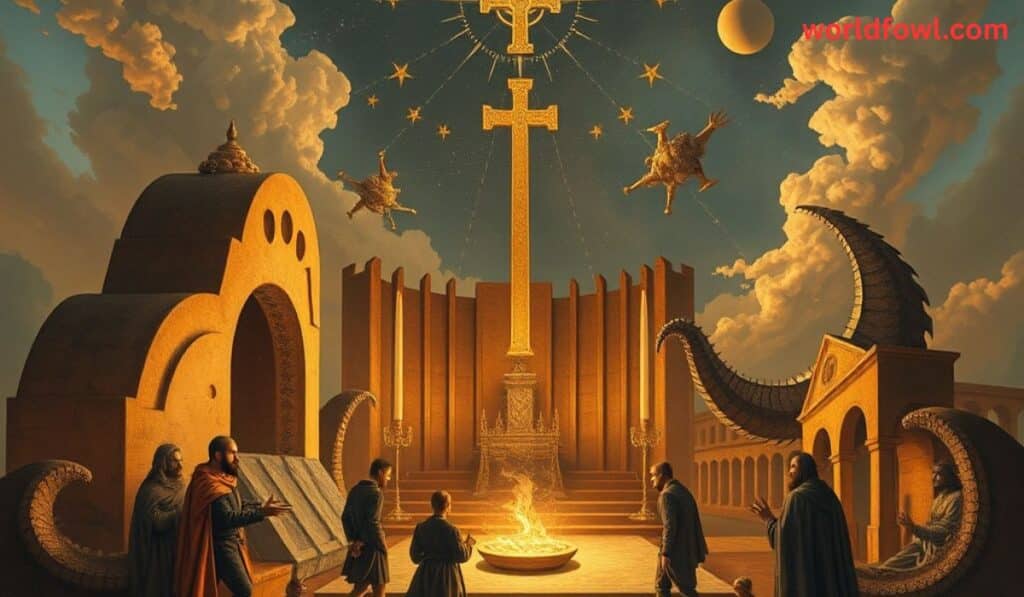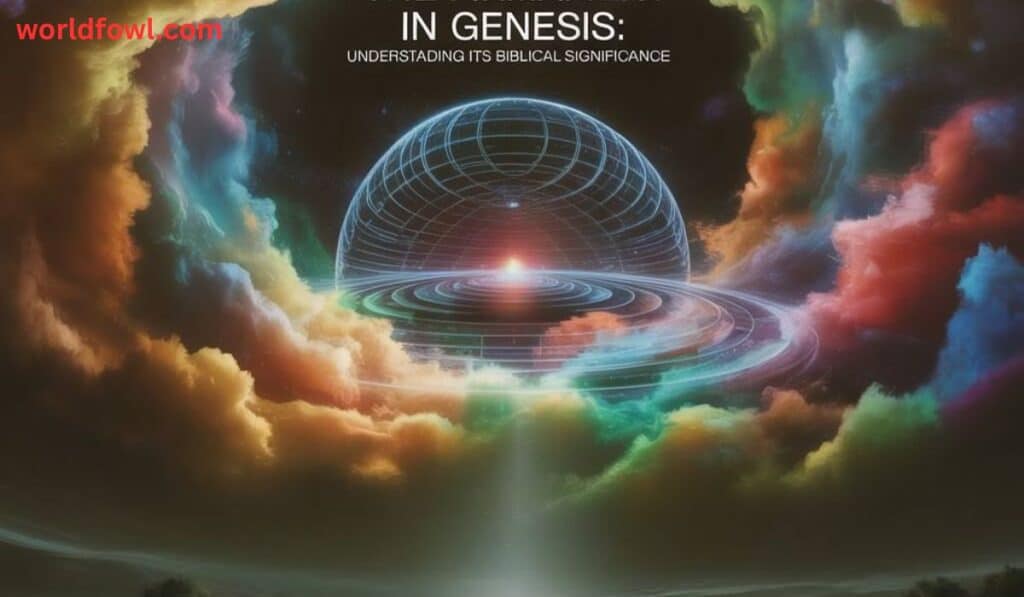The Firmament in Genesis: Understanding Its Biblical Significance refers to the divine expanse created by God on the second day, separating the waters above from the waters below, and named “Heaven” in Scripture. This concept, drawn from Genesis 1:6–8, highlights God’s intentional design in shaping the cosmos with order and purpose.
Majestic and deeply symbolic, the firmament stands as more than a physical sky. It reflects divine craftsmanship, turning chaos into harmony and offering profound insights into biblical cosmology. Its layered meaning has fascinated believers, theologians, and scholars across centuries.The Firmament in Genesis: Understanding Its Biblical Significance
Exploring The Firmament in Genesis: Understanding Its Biblical Significance reveals its role in creation, theology, and spirituality. It symbolizes God’s sovereignty, the beauty of divine order, and the heavens declaring His glory. This study not only uncovers ancient interpretations but also inspires modern readers to reflect on God’s eternal presence in both the physical and spiritual realms.
Decoding the Hebrew: What Raqia Actually Means
The raqia Hebrew word comes from the root raqa, meaning “to beat out,” “to spread,” or “to expand.” Ancient metalworkers used this term when hammering gold into thin sheets or beating metal into desired shapes. This imagery wasn’t accidental—it reveals how the original Hebrew audience understood God’s creative work.
Etymology and Ancient Context
Picture a skilled craftsman hammering precious metal on an anvil. Each strike spreads and shapes the material with purpose and precision. This is exactly how ancient Hebrews conceptualized God creating the heavenly expanse. The biblical cosmology of the time envisioned a dome-like structure that God “hammered out” to separate the cosmic waters.
The Septuagint translators chose stereoma, emphasizing the solid, firm nature of this structure. This Greek term carried connotations of strength and permanence—qualities that resonated with their understanding of divine order in creation.
Translation Evolution
| Translation | Term Used | Emphasis |
|---|---|---|
| Hebrew Original | Raqia | Beaten-out expanse |
| Septuagint (Greek) | Stereoma | Solid firmament |
| Latin Vulgate | Firmamentum | Fixed structure |
| King James Version | Firmament | Established boundary |
| Modern Versions | Expanse/Vault | Space/Atmosphere |
The King James Version’s “firmament” dominated English understanding for centuries. However, modern translations like “expanse” attempt to capture the spatial concept without implying specific physical properties.
Why Translation Matters
Understanding the raqia Hebrew word prevents us from imposing modern scientific concepts onto ancient texts. The biblical authors wrote within their cultural context, using familiar imagery to convey profound spiritual truths about God’s creative power and divine boundary establishment.
The Firmament’s Creative Function in Genesis 1
Genesis 1:6-8 presents the firmament as God’s solution to primordial chaos. Before this creative act, waters covered everything in formless confusion. God’s expanse in creation brought order, purpose, and structure to the cosmos.
Water Separation Mechanism
“Then God said, ‘Let there be a firmament in the midst of the waters, and let it divide the waters from the waters.'” The division of waters represents one of creation’s most significant organizational acts.
The waters above and waters below concept reflects ancient understanding of cosmic structure. Upper waters provided rain and weather, while lower waters formed seas and rivers. This separation of divine and earthly realms established the framework for all subsequent life.
Ancient Near Eastern cultures shared similar cosmological views:
- Mesopotamian texts described Marduk creating heaven by splitting Tiamat’s body
- Egyptian mythology portrayed Nut (sky goddess) arched over Geb (earth god)
- Canaanite literature referenced divine waters above the heavens
Sky Designation and Boundaries

On the creation story second day, God called the firmament Heaven. This naming ceremony carried profound significance in Hebrew thought. To name something meant exercising authority over it, establishing its purpose and identity.
The Hebrew shamayim (heavens) literally means “the heights” or “lofty places.” This designation emphasized:
- Separation between God’s realm and human habitation
- Order replacing cosmic chaos
- Beauty reflecting divine craftsmanship
- Purpose providing space for celestial functions
Platform for Celestial Architecture
Day Four’s events reveal the firmament’s ultimate purpose. Sun moon and stars in firmament weren’t afterthoughts—they represented God’s planned culmination of celestial organization.
Genesis 1:14-17 describes how God set luminaries “in the firmament of the heavens” to:
- Provide light for earth
- Separate day from night
- Mark time and seasons
- Serve as signs for navigation
The phrase “windows of heaven” in Genesis 7:11 during Noah’s flood suggests the firmament contained regulated openings. These floodgates of heaven could release upper waters when God determined, demonstrating His continued sovereignty over creation’s structure.
Three Interpretative Lenses
Modern readers approach the biblical firmament through various interpretative frameworks. Each perspective offers valuable insights while acknowledging the text’s ancient context and enduring theological significance.
Ancient Hebrew Cosmological View
The ancient Hebrew cosmology envisioned a three-tiered universe with Earth at the center, surrounded by cosmic waters, and enclosed by a solid dome.
Key elements included:
- Solid dome concept: The firmament as beaten metal protecting Earth
- Cosmic temple model: Creation structured like Israel’s tabernacle
- Hierarchical arrangement: Heaven above, earth in middle, sheol below
- Divine throne room: God’s dwelling above the highest heavens
Archaeological discoveries support this interpretation:
- Babylonian creation accounts describe similar cosmic structures
- Egyptian tomb paintings show sky goddess arched over earth
- Mesopotamian cylinder seals depict domed heavens with stars
Literary-Theological Framework
Many scholars advocate reading Genesis 1:6-8 as functional rather than material creation. This theological interpretation of firmament emphasizes God’s establishment of cosmic roles and purposes rather than physical manufacturing.
John Walton’s cosmic temple theory suggests:
- Creation establishes God’s cosmic temple
- The firmament creates sacred space for worship
- Divine order in creation parallels tabernacle construction
- Function matters more than physical structure
This view harmonizes ancient cosmology with modern science by focusing on theological truth rather than scientific description. God accommodated human understanding while revealing eternal principles about His nature and sovereignty.
Scientific Integration Attempts
Contemporary believers often seek to correlate the biblical firmament with modern atmospheric science. Common approaches include:
Atmosphere Theory: The firmament represents Earth’s atmosphere, separating surface water from atmospheric moisture. This interpretation aligns with meteorological processes while maintaining biblical authority.
Space Expanse View: The firmament describes the vast expanse of space containing celestial bodies. This perspective accommodates modern astronomy while preserving scriptural integrity.
Gap Theory Application: Some propose the firmament resulted from catastrophic restructuring between Genesis 1:1 and 1:2, allowing for geological ages while maintaining recent creation of life.
Each approach attempts to honor both biblical interpretation of nature and scientific discovery, though none perfectly resolves all questions.
Cross-Biblical Firmament References

Scripture’s poetic description of creation appears throughout the Old and New Testaments, reinforcing the firmament’s theological significance beyond Genesis.
Psalmic Celebrations
Psalm 19:1 firmament declares: “The heavens declare the glory of God; and the firmament shows His handiwork.” This verse establishes the heavens declare the glory of God theme that resonates throughout Scripture.
The psalmist recognizes the spiritual significance of heavens as God’s testimony to His character:
- Power: Demonstrated through cosmic scale and beauty
- Wisdom: Revealed in celestial precision and order
- Faithfulness: Shown through consistent natural laws
- Creativity: Expressed in stellar diversity and complexity
Prophetic Visions
Ezekiel 1:22-26 firmament presents a stunning vision: “The likeness of the firmament above the heads of the living creatures was like the color of an awesome crystal, stretched out over their heads.” This Ezekiel 1:22–26 firmament passage connects earthly worship with heavenly reality.
The prophet’s description emphasizes:
- Crystal transparency: Revealing God’s purity and holiness
- Awesome appearance: Inspiring reverent worship
- Protective covering: Sheltering God’s throne-chariot
- Reflective surface: Displaying divine glory
Apocalyptic Imagery
Daniel 12:3 firmament promises: “Those who are wise shall shine like the brightness of the firmament.” This verse links human righteousness with cosmic brilliance, suggesting the eternal perspective of Heaven awaits faithful believers.
Revelation 4:6 describes “a sea of glass, like crystal” before God’s throne, possibly referencing the firmament’s crystal-like appearance. This connection emphasizes continuity between creation’s structure and heaven’s reality.
Theological Implications and Modern Application

The biblical firmament carries profound implications for understanding God’s character, humanity’s role, and creation’s ultimate purpose.
God’s Creative Order
The firmament demonstrates God’s commitment to transforming chaos to order. Before the second day, formless waters dominated the cosmos. God’s creative word brought:
Structure: Establishing clear boundaries and relationships
Purpose: Assigning specific functions to cosmic elements
Beauty: Creating a magnificent framework for life
Stability: Providing reliable patterns for human flourishing
This divine order in creation reveals God’s nature as one who brings meaning from meaninglessness, purpose from confusion, and beauty from chaos.
Humanity’s Place in Creation
The firmament positions humanity uniquely within God’s ordered cosmos. We exist:
- Under heaven’s canopy: Protected and provided for
- Above earthly chaos: Elevated through divine image-bearing
- Between realms: Capable of heavenly worship and earthly stewardship
- Within purpose: Called to reflect God’s creative order
This positioning carries responsibilities:
- Stewardship: Caring for creation’s structure, balance, beauty
- Worship: Recognizing the majesty of heavens as God’s handiwork
- Proclamation: Declaring God’s glory revealed in cosmic design
- Anticipation: Longing for new heavens and new earth
Eschatological Connections
The eternal destiny in Scripture involves new heavens and new earth where God’s original creative intentions find perfect fulfillment. Revelation 21:1 promises renovation, not annihilation, of cosmic structure.
The firmament’s symbolic meaning points toward:
- Divine dwelling: God’s permanent presence with humanity
- Perfect order: Complete harmony replacing all chaos
- Unveiled glory: Direct access to God’s throne
- Eternal worship: Unhindered praise ascending to heaven
Addressing Common Questions and Misconceptions
Modern readers often struggle with apparent conflicts between ancient cosmology and contemporary science. Understanding proper biblical interpretation helps resolve these concerns.
“Does the Bible Teach a Flat Earth?”
The biblical cosmology question requires careful attention to literary genre and cultural context. Scripture uses phenomenological language—describing appearances rather than scientific mechanisms.
Consider these principles:
- Accommodation: God spoke in terms ancient audiences could understand
- Function over form: Genesis emphasizes theological truth over scientific detail
- Literary genre: Recognizing poetic and metaphorical elements
- Progressive revelation: Later Scripture clarifies earlier passages
Science vs. Scripture False Dichotomy
Faithful Christians need not choose between biblical authority and scientific discovery. Both reveal different aspects of God’s truth:
| Scripture Reveals | Science Discovers |
|---|---|
| Who created | How creation functions |
| Why creation exists | When events occurred |
| Creation’s purpose | Natural mechanisms |
| God’s character | Physical properties |
| Human significance | Cosmic measurements |
Literary Genre Recognition
Understanding biblical interpretation of nature requires recognizing different literary styles within Scripture:
Historical narrative: Factual accounts of God’s actions
Poetic description: Metaphorical language expressing truth
Prophetic imagery: Symbolic representations of spiritual reality
Wisdom literature: Practical observations about creation
The firmament passages contain elements of each genre, requiring careful exegetical work to understand their intended meaning.
Practical Spiritual Lessons
The biblical firmament offers timeless spiritual insights for contemporary believers navigating life’s complexities.
God Creates Boundaries for Purpose
Just as God established the firmament to separate waters, He sets boundaries in our lives for protection and flourishing. These divine boundaries include:
- Moral guidelines: Protecting relationships and character
- Natural laws: Providing stability and predictability
- Spiritual disciplines: Creating space for growth and worship
- Life circumstances: Shaping character through challenges
Divine Order Brings Peace from Chaos
The chaos to structure transformation demonstrates God’s desire for order in every area of life. When we experience confusion or turmoil, we can trust God’s ability to bring:
- Clarity from confusion
- Purpose from meaninglessness
- Hope from despair
- Direction from wandering
Worship Flows from Understanding God’s Majesty

The heavens as testimony of God’s glory inspire authentic worship. As we contemplate the firmament’s beauty and complexity, our hearts naturally respond with:
- Awe at God’s creative power
- Gratitude for His provision and care
- Humility recognizing our proper place in creation
- Joy celebrating His magnificent handiwork
Trusting God’s Design Even When Mysterious
The firmament reminds us that God’s ways often transcend human understanding. We can trust His divine design even when:
- His methods seem unusual
- His timing appears delayed
- His purposes remain hidden
- His plans challenge our expectations
This faith in divine design sustains believers through seasons of uncertainty and doubt.
The Firmament’s Enduring Legacy
The Firmament in Genesis continues shaping Christian thought, worship, and worldview thousands of years after its recording. This remarkable biblical concept bridges ancient cosmology with eternal spiritual truths, demonstrating Scripture’s enduring relevance.
From the raqia Hebrew word describing God’s hammered-out expanse to modern believers gazing upward in wonder, the firmament testifies to divine creativity, order, and purpose. Whether we understand it as literal cosmic architecture or functional theological imagery, its message remains clear: God transforms chaos into beauty, establishes protective boundaries, and creates magnificent spaces for worship and relationship.
The division of waters, sun moon and stars in firmament, and God called the firmament Heaven all point toward the same profound truth—our Creator delights in bringing order from confusion and purpose from chaos. As Psalm 19:1 declares, the heavens declare the glory of God, and the firmament continues proclaiming His handiwork to every generation.
In our modern world filled with uncertainty and chaos, the firmament offers hope. Just as God established cosmic boundaries and brought order to primordial waters, He continues working in our lives, relationships, and circumstances. The same divine power that created the heavenly expanse remains active today, transforming our chaos into His ordered beauty, our confusion into His perfect peace.
Whether you approach the firmament through ancient Hebrew cosmology, theological interpretation, or scientific integration, its central message endures: God creates, God orders, God provides, and God delights in revealing His glory through the magnificent cosmos He has made. The firmament stands as an eternal reminder that we serve a God who brings structure, balance, beauty to every area of existence—including our own.
conclusion
The Firmament in Genesis: Understanding Its Biblical Significance shows how God brought order and meaning to creation. It was not only a division of waters but also a symbol of His power and glory. The firmament points to balance, beauty, and the heavenly design that reflects God’s sovereignty.
For believers today, The Firmament in Genesis: Understanding Its Biblical Significance is more than history. It is a reminder of God’s authority and presence. Each look at the heavens inspires faith, gratitude, and trust in the Creator’s eternal plan.
FAQs
Q1: What is the firmament in Genesis?
The firmament in Genesis is the expanse God created on the second day to separate the waters above from the waters below, called “Heaven.”
Q2: What does the Hebrew word “raqia” mean?
“Raqia” means something spread out or stretched, often seen as an expanse or dome in biblical context.
Q3: How is the firmament viewed in modern times?
Today, many scholars view the firmament as a symbolic or poetic description of the sky and atmosphere.
Q4: What is the spiritual meaning of the firmament?
It represents God’s sovereignty, order, and the heavens declaring His glory.The Firmament in Genesis: Understanding Its Biblical Significance
Q5: Where else is the firmament mentioned in the Bible?
It appears in passages like Genesis 1:6–8, Psalm 19:1, Ezekiel 1:22–26, and Daniel 12:3.








